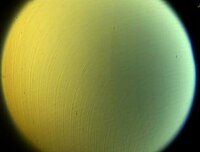
Photo from wikipedia
The DART spacecraft will impact Didymos’s secondary, Dimorphos, at the end of 2022 and cause a change in the orbital period of the secondary. For simplicity, most previous numerical simulations… Click to show full abstract
The DART spacecraft will impact Didymos’s secondary, Dimorphos, at the end of 2022 and cause a change in the orbital period of the secondary. For simplicity, most previous numerical simulations of the impact used a spherical projectile geometry to model the DART spacecraft. To investigate the effects of alternative, simple projectile geometries on the DART impact outcome we used the iSALE shock physics code in two and thee-dimensions to model vertical impacts of projectiles with a mass and speed equivalent to the nominal DART impact, into porous basalt targets. We found that the simple projectile geometries investigated here have minimal effects on the crater morphology and momentum enhancement. Projectile geometries modelled in twodimensions that have similar surface areas at the point of impact, affect the crater radius and the crater volume by less than 5%. In the case of a more extreme projectile geometry (i.e., a rod, modelled in three-dimensions), the crater was elliptical and 50% shallower compared to the crater produced by a spherical projectile of the same momentum. The momentum enhancement factor in these test cases, commonly referred to as β, was within 7% for the 2D simulations and within 10% for the 3D simulations, of the value obtained for a uniform spherical projectile. 1 ar X iv :2 20 1. 01 73 0v 1 [ as tr oph .E P] 5 J an 2 02 2 The most prominent effects of projectile geometry are seen in the ejection velocity as a function of launch position and ejection angle of the fast ejecta that resides in the so-called ‘coupling zone’. These results will inform the LICIACube ejecta cone analysis.
Journal Title: International Journal of Impact Engineering
Year Published: 2022
Link to full text (if available)
Share on Social Media: Sign Up to like & get
recommendations!